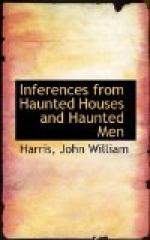Perhaps it may be guessed that the three gentlemen travelled with no heavy luggage, and their identity and destination was not detected. The vision seen most was that of a nun in the black dress commonest among nuns.
It was seen moving about on a very steep bank, a bank apparently too steep for walking, and was only visible against the snow. Miss Freer did not look on the bank for tracks.
It may be noted that on the two previous days in the neighbourhood of this glen a terrier, who never barked except under strong excitement, had barked at the same hour, but no vision was seen; on the 6th of February the dog had been taken off in another direction. After seeing the vision in the glen, Miss Freer almost always heard strange sounds at night.
The inference is that in the glen, where there was plenty of cover, and where, judging by the dog’s barking, suspicious persons lurked, Miss Freer was hypnotised, made to see an apparition, and left susceptible to a further operation that night. Later on it says, “the dog ran up, pointed, and ran straight for the two women.” This was on the second occasion of a grey woman appearing, and the third occasion of the black nun being seen. He was found barking in the glen; no cause could be found; a lurking stranger is a possible explanation. It may be noted, that the pointing attitude in a dog of the smaller breeds means reflection, and that something puzzled it, perhaps its mistress’s attitude; but its going on barking would indicate the steady retreat of some one who frightened it.
At least three voices were heard—perhaps more. Phenomena were scarce; the gang’s powers were still limited, though the horror they inflicted showed that they reached the bounds of some of the victims’ strength. Miss Freer not only heard sounds in the house, where she was less exposed than in the glen, but saw apparitions on four occasions.
The visions that can be inflicted telepathically, i.e. hypnotically, seem to be at first limited to two kinds—first, the vision of the person himself: this hallucination has often been effected by honest experimentalists; secondly, and this is rather matter of inference, a rascal who has hypnotised a person may be unable to get rid of the image of his victim, and transfers the ghost that haunts him to another subject.
The portrait of a so-called Nathan Early, at the beginning of Osgood Mason’s book, has the eyebrows, eyes, and mouth of a much mesmerised man. The mouth has not become stiffened into a laugh, as he was of a gentle firm disposition, and the hypnotism probably was from a distance.
The possessed hypnotist transferred it to his victim, Mrs. Juliette Burton.
The qualification, “at first,” is important; visions are perhaps not easily transferred to a new subject, but the question of what is good policy for the rascals may have to be considered. This may limit the experience of those who have been more seriously victimised than Miss Freer and her garrison were.




